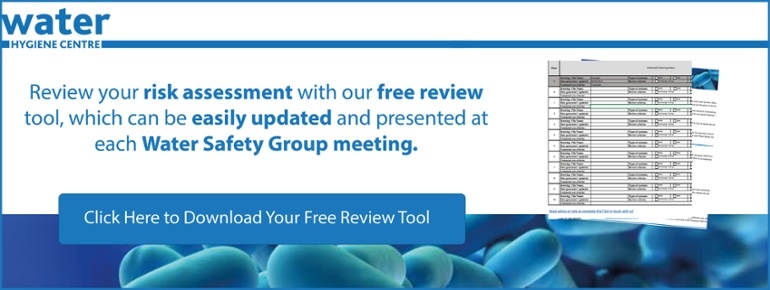A Legionella Written Scheme of Control is quite simply it’s a written document that details the characteristics, components, operational methods, and management of your water system to help maintain the compliant control of Legionella bacteria.
Why do you have to have a Legionella Written Scheme of Control?
This ‘blog’ assumes that ACOP L8 is the chosen approach to control legionella bacteria in your water systems. Are you aware that any water system, that can release water and create aerosols, should have a Legionella written scheme of control to demonstrate that you are complying with the Management of Health and Safety at Work Regulations 1999? The content of the Legionella written scheme of control should be concise and accurate to reflect the simplicity/complexity of the water system in question.
New Water Systems and Capital Projects
Whether your water system is a large complex centralised system, a simple mains cold water system with local hot-water heaters, or a water feature for example, ALL water systems were initially at the design stage where the preliminary information for the Legionella written control scheme should start. Through the design phase risk assessment, designers should identify risks that exist because they cannot be ‘designed out’ of the water system. This way the required preventative measures can be considered early and passed to the Contractor.
 The Operating and Maintenance (O&M) manual should have a Legionella-specific section that identifies that the design of the individual water systems is based on the requirements of ACOP L8 and which part of HSG274 is applicable. The information must be clearly written in a style that non-technical readers can understand. All too often O&M’s have information for the water systems spread across various sections e.g. Architectural for the specified outlets, Mechanical for the design of plant and equipment up to service valves, and Building Management System for the automated controls, and bulked out with irrelevant manufacturers blurb which makes it difficult to find the correct information and implement the operational management activities.
The Operating and Maintenance (O&M) manual should have a Legionella-specific section that identifies that the design of the individual water systems is based on the requirements of ACOP L8 and which part of HSG274 is applicable. The information must be clearly written in a style that non-technical readers can understand. All too often O&M’s have information for the water systems spread across various sections e.g. Architectural for the specified outlets, Mechanical for the design of plant and equipment up to service valves, and Building Management System for the automated controls, and bulked out with irrelevant manufacturers blurb which makes it difficult to find the correct information and implement the operational management activities.
Appendix 2 of HSG274 Part 2 (The control of Legionella bacteria in hot and cold-water systems) details information required from the combined effort of those involved in the design/specification of the water system, the installer, and the Duty Holder/Responsible Person. Ideally, the appointment of an Authorised Person (Design) would liaise with the Authorised Person (Operations) in compiling the relevant and complete information before the handover and soft landings phase.
Existing Water Systems
If you find yourself inheriting/operating an existing water system that doesn’t have a Legionella written scheme of control it is advised that one is produced as soon as possible.
You may find that the information is already available and needs compiling into a specific Legionella written scheme of control for the system e.g. if you have a Legionella risk assessment, that is suitable and sufficient, the system information and operational maintenance requirements should be contained therein. Part of the written scheme of control will be covered by implementing the recommendations of the risk assessment e.g. appointing a water hygiene contractor to deliver planned and preventative maintenance activities. This may have already taken place but this decision/appointment may not have been documented in the Legionella written scheme of control.
What should be included in your Legionella Written Scheme of Control?
As referred to earlier, Appendix 2 of HSG274 Part 2 details the information required for your Legionella written scheme of control. Written in a clear non-technical form the written scheme of control, in a nutshell, should be specific, relevant, concise and…...
- Identify the water system in question giving reference to the specific risk assessment and accurate as-installed record drawings,
- Describe what is required for operational and maintenance management, e.g. description of how the design is intended to operate, temperature monitoring, etc.
- Indicate who will undertake routine duties listed in the scheme by giving the complete management structure
- Explain how tasks and duties are to be delivered compliantly by identifying competency/training requirements of those responsible,
- Describe an incident plan/remedial action in the event of failure.
Jargon!!
There are multiple examples across various pertinent documents as to what a Legionella written scheme of control is, which doesn’t help consistency. They do, however, all attempt to achieve the same thing. Other names used are Legionella written control scheme, written scheme, written control scheme, written scheme of precautions, written scheme of measures, written instructions, scheme of control, and written scheme of legionella control.
Reviewing the Legionella Written Scheme of Control?
 Your written scheme should be reviewed and updated, in conjunction with the Legionella risk assessment, in anticipation of a significant change or when there has been a failure in your control measures. Examples of changes that require you to update your written scheme are similar to those for your Legionella risk assessment.
Your written scheme should be reviewed and updated, in conjunction with the Legionella risk assessment, in anticipation of a significant change or when there has been a failure in your control measures. Examples of changes that require you to update your written scheme are similar to those for your Legionella risk assessment.
If you have questions regarding the issues raised above or you would like to speak with one of our consultants, please click here to get in touch.
Editors Note: The information provided in this blog is correct at the date of original publication – October 2024.
© Water Hygiene Centre 2024









